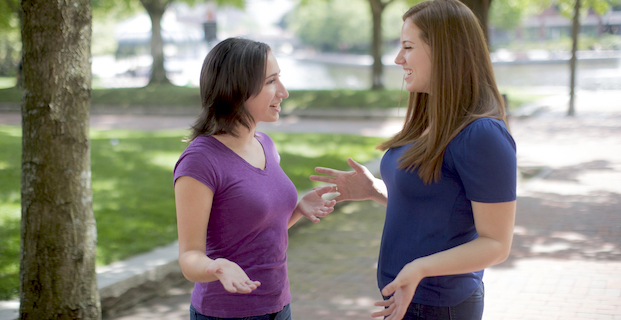Use Every Tool Available to Say What You Mean

If you’ve been reading our blog posts, you already appreciate the value of clear communication. You already know how to give an effective compliment. And you already understand the power of body language.
When you have something to say — whether it’s an energizing presentation to your team or a big sales pitch to a new client — how you say it matters as much as what you say. Your actual words may go in one ear and out the other, but your attitude and demeanor leave a lasting impression. How you say it involves your:
- Body language
- Hand gestures
- Facial expressions
- Tone of voice
- Eye contact
- Environmental circumstances
How You Say It with Body Language
We’re writers. Words matter to us on many levels. So when we tell you that your spoken words to a group or even one-on-one convey very little, you have to believe it. We’d prefer it to be false, but it’s been proven again and again, and we can’t ignore it. Your body language when speaking says much more than the words you utter.
The number, in fact, is seven percent. What you say contributes only seven percent of your message. How you say it with your body language and other unspoken cues provide the other 93 percent. Be conscious of your body when you speak. Use it to convey and reinforce your message. When people listen to you, they’re watching your body language. A confident posture lends weight to your words.
How You Say It with Hand Gestures
Some people tend to talk with their hands. Their extended pinky and thumb become a telephone receiver. A pointed index finger and thumb become a pistol. Sometimes, a conversation consumes their full reach. But gestures add emphasis to your words, just as a conductor punctuates the music with his gesticulations.
Your audience wants to know that they can trust you. Yet no one trusts a speaker whose arms hang limply. Your hand gestures can win an audience over. Watch any great speaker; every one of them use their hands to sweep meaning into their words. So help your listeners understand the full extent of your message by incorporating hand gestures into how you say it.
How You Say It with Facial Expressions
Like body language and hand gestures, your facial expressions communicate lots of information on their own. Think of the very different messages you express when you say, “I love to write blog posts” — once while smiling broadly and once when scowling. The same words take on opposite meanings. No matter what you say, people are watching your face for clues to your attitude. Use your expression in conjunction with your words. Put the whole package together to make your point stronger.
You can convey your mood, your emotions and your attitude with just a look. Even if your audience doesn’t consciously process your expression, it sticks in their minds. They can’t help but understand it. That’s just part of human nature. You’d do yourself a disservice if you didn’t use your facial expressions to guide your listeners toward a deeper understanding.
How You Say It with the Tone of Your Voice
Communication is a multi-sensory experience. When people listen, their ears naturally open. Their eyes observe. Their noses are actually on alert for pleasurable or foul smells. The brain puts the input together into a package that helps the brain not only accept the information provided, but also to decide whether to trust the speaker.
How you say something — how you use the inflection, pitch and tone of your voice — engages your audience directly. It’s so important in the art of storytelling that it’s become part of how we communicate. You can express tension, surprise or gravity through the tone of your voice. When you use it to reinforce your message, your message has a more lasting impact. Use your voice to connect with your listeners.
How You Say It with Eye Contact
To connect with someone, you have to look them in the eye. That look conveys trust and honesty. While it’s easy to do when you’re talking one-on-one with someone, it’s a feat when you’re speaking to a group. But spread the love around the room. Maintain eye contact with individuals for several seconds before moving on. That connection opens the brain to be more receptive.
Eye contact is a necessary part of building trust with people. But you have to create a delicate balance. If you don’t maintain eye contact long enough, you lose any good will you intended. Look too long at one person, however, and it becomes a weird power play between you and the audience member. Make your presence real by connecting with your audience through eye contact.
How Environmental Circumstances Impact What You Say
It’s not so much what you say as to what your audience hears. If you’re holding court in the midst of a crowded subway station, few are going to pay you any attention. If you’re speaking to your crack management team in a pristine conference room, on the other hand, you can be sure that everyone is hanging on every word.
By providing an environment that’s conducive to the meaning of your message, you encourage your audience to better absorb that message. A comforting environment puts all the focus on your speech, as there are no distractions. And then, if you’re using all your nonverbal clues, you can reach your audience more effectively. And that’s the key to communication.
Ray Access is a content marketing firm that delivers targeted words to empower your business to succeed. Contact us about your specific project to receive a quote. We write website copy, blog posts, e-newsletters, and more. Everything we do is thoroughly researched, professionally edited and guaranteed original.
